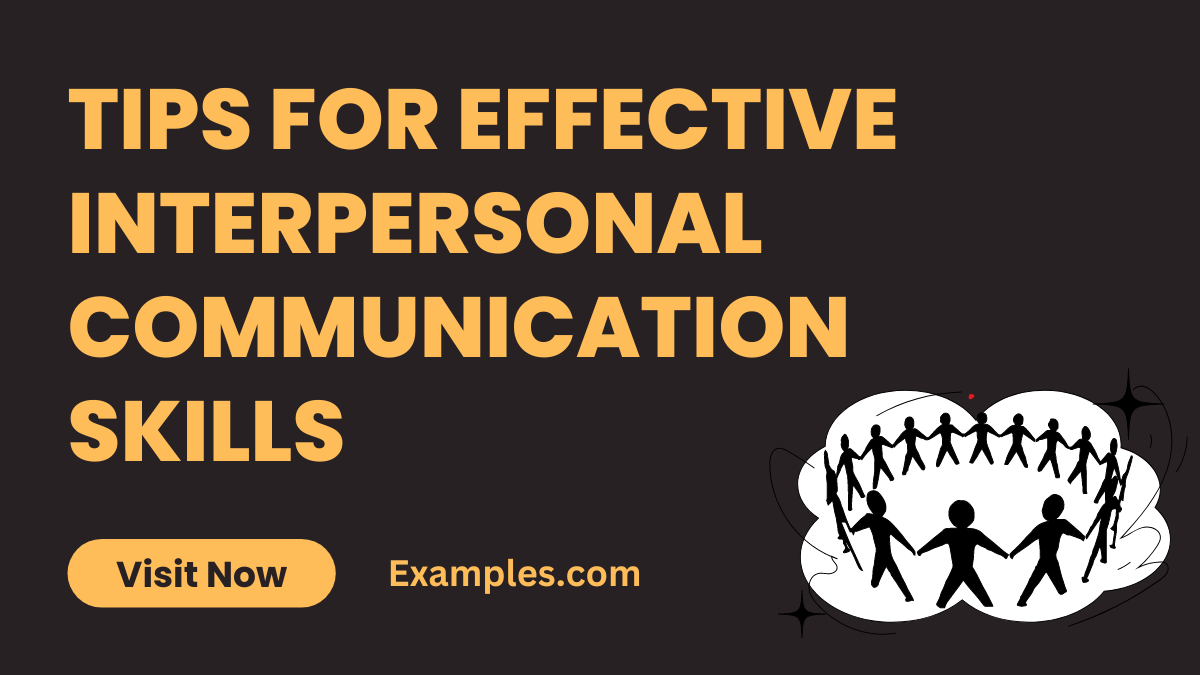30+ Tips for Effective Interpersonal Communication Skills
Unlock the potential of interpersonal communication with this comprehensive guide, filled with practical communication examples. These tips aren’t just theoretical; they are life-changing tools that can improve how you interact in every sphere of your life. From mastering the art of active listening to learning the subtleties of body language, this guide offers a wealth of knowledge. Whether you’re looking to enhance personal relationships or elevate professional interactions, these tips will provide you with the skills needed for effective and meaningful communication. Step into a world where every conversation becomes an opportunity for connection and understanding.
30 Tips for Effective Interpersonal Communication Skills

Embrace the art of interpersonal communication with these 30 transformative tips. Each tip is a stepping stone to building stronger, more meaningful connections in both personal and professional realms. From honing your listening skills to mastering the nuances of body language, this guide is a treasure trove of practical advice. These communication examples illustrate how to apply these skills in real-life scenarios, enhancing your ability to engage, empathize, and connect with others on a deeper level.
- Practice Active Listening: Focus fully on the speaker, showing genuine interest.Active listening involves fully concentrating on the speaker, understanding their message, and responding thoughtfully. It’s a vital skill in interpersonal communication, enabling deeper understanding and connection.
Example: “I understand you’re feeling overwhelmed. Let’s discuss this in detail.” - Use Clear, Concise Language: Communicate your message in a straightforward manner.Effective communication requires conveying your message in a simple, straightforward way. This approach minimizes misunderstandings and ensures that your message is easily comprehensible.
Example: “My goal for this project is clearly defined and achievable.” - Maintain Eye Contact: Eye contact shows engagement and sincerity. Eye contact is a powerful non-verbal cue that conveys confidence, sincerity, and engagement. It plays a critical role in building trust and rapport in conversations.
Example: “When I talk to you, I maintain eye contact to show I’m fully present.” - Be Mindful of Your Body Language: Non-verbal cues are as important as words.Your body language can often speak louder than words. Being aware of your gestures, posture, and facial expressions is crucial in sending the right message.
Example: “I keep my posture open and approachable during conversations.” - Show Empathy: Understand and share the feelings of others.Empathy involves understanding and sharing the feelings of another. Demonstrating empathy in communication fosters stronger connections and deeper relationships.
Example: “I can see why that situation was frustrating for you.” - Ask Open-Ended Questions: Encourage deeper discussion and understanding.Empathy involves understanding and sharing the feelings of another. Demonstrating empathy in communication fosters stronger connections and deeper relationships.
Example: “What do you think led to this outcome?”

- Give Constructive Feedback: Offer feedback that is helpful and positive.Constructive feedback is essential for growth and improvement. It should be delivered in a way that is helpful, specific, and positive.
Example: “Your report was thorough; maybe adding more data could enhance it further.” - Adapt to Communication Styles: Tailor your approach to different people.Recognizing and adapting to different communication styles helps in effectively reaching out to various individuals, enhancing mutual understanding.
Example: “I notice you prefer concise emails, so I adjust my communication accordingly.” - Use Affirming Words: Positive language can uplift and encourage.Positive affirmations can significantly impact someone’s confidence and motivation. Using affirming language helps in building a positive and encouraging communication environment.
Example: “I really appreciate your hard work on this.” - Be Patient: Take time to understand the situation and respond thoughtfully.Patience in communication allows for a more thoughtful and comprehensive understanding, reducing the likelihood of hasty judgments and misunderstandings.
Example: “I take a moment to think before responding to ensure clarity.” - Avoid Interrupting: Let others finish their thoughts without interruption.Allowing others to finish their thoughts without interruption shows respect and interest in what they have to say.
Example: “I wait for you to finish speaking before I respond.” - Express Gratitude: Showing appreciation can strengthen relationships.Expressing gratitude not only shows appreciation but also strengthens interpersonal relationships and builds a positive communication climate.
Example: “Thank you for your insightful contribution to our discussion.” - Recognize Non-Verbal Signals: Be aware of unspoken messages in body language.Being attuned to non-verbal signals like facial expressions and body language provides deeper insights into the emotions and thoughts of the communicator.
Example: “I noticed your concern through your body language and addressed it.” - Practice Self-Disclosure: Sharing personal experiences can build trust.Sharing personal experiences and feelings can build trust and rapport in relationships, fostering deeper connections.
Example: “I shared a personal story to connect on a deeper level.” - Stay Open-Minded: Be receptive to new ideas and perspectives.Keeping an open mind in communication encourages a welcoming environment for diverse ideas and perspectives.
Example: “I consider different viewpoints to broaden my understanding.” - Manage Emotions: Keep your emotions in check during conversations.Effective communication requires the ability to manage your emotions, especially in situations that are tense or challenging.
Example: “I stay calm even when discussions become heated.” - Use Humor Wisely: Appropriate humor can lighten the mood.Appropriately timed and contextually relevant humor can lighten conversations and ease tensions, enhancing the connection between communicators.
Example: “A light-hearted comment eased the tension in our meeting.” - Clarify Misunderstandings: Address and resolve any confusion promptly.Prompt clarification of misunderstandings prevents the escalation of conflicts and preserves the clarity of communication.
Example: “I asked for clarification to avoid any misunderstandings.” - Respect Differences: Acknowledge and value diverse opinions.Respecting and valuing diverse viewpoints and experiences enriches conversations and leads to a more inclusive communication environment.
Example: “I respect your opinion, even though it differs from mine.” - Be Assertive, Not Aggressive: State your needs respectfully.Assertiveness involves expressing your views confidently and respectfully, without overriding the rights of others.
Example: “I express my needs clearly without being confrontational.” - Practice Paraphrasing: Ensure understanding by restating others’ points.Paraphrasing helps to confirm understanding of the message and shows that you are actively engaged in the conversation.
Example: “So, what you’re saying is…” - Be Present: Fully engage in the conversation without distractions.Being fully present in the moment demonstrates respect and value for the conversation and the person you are communicating with.
Example: “I put away my phone to focus entirely on our conversation.” - Use Inclusive Language: Ensure everyone feels acknowledged.Inclusive language ensures that everyone feels respected and included, promoting a positive and welcoming communication environment.
Example: “We all have a role to play in this project.” - Be Honest: Transparency builds trust and credibility.Honesty in communication builds trust and credibility, which are fundamental to strong and lasting relationships.
Example: “I speak truthfully, even when it’s difficult.”

- Develop Cultural Sensitivity: Understand and respect cultural differences.Honesty in communication builds trust and credibility, which are fundamental to strong and lasting relationships.
Example: “I educate myself on cultural norms to communicate respectfully.” - Maintain Confidentiality: Respect privacy and confidentiality.Respecting confidentiality in communication builds trust and shows that you are a reliable and responsible communicator.
Example: “I keep sensitive information discussed in confidence.” - Encourage Feedback: Invite others to share their thoughts and opinions.Inviting feedback demonstrates openness and willingness to engage in two-way communication, fostering a collaborative environment.
Example: “What are your thoughts on this approach?” - Seek Common Ground: Find areas of agreement to build on.Finding common ground helps in building a foundation for understanding and cooperation in communication.
Example: “Let’s focus on what we agree on and build from there.” - Stay Positive: A positive attitude can influence interactions favorably.A positive attitude in communication influences the overall tone of the conversation and helps in maintaining a constructive and optimistic dialogue.
Example: “I maintain a positive outlook, even in challenging situations.” - Reflect and Learn: Continuously evaluate and improve your communication skills.Continuous reflection and learning from your communication experiences is key to developing and enhancing your interpersonal communication skills.
Example: “I reflect on my conversations to learn and grow.”
In conclusion, this guide on Tips for Effective Interpersonal Communication Skills provides invaluable insights and practical strategies for enhancing communication abilities. Whether in personal or professional settings, these tips and examples offer a roadmap to more meaningful, effective interactions. Embracing these skills will not only improve your communication but also strengthen your connections with others, fostering better understanding and collaboration.



